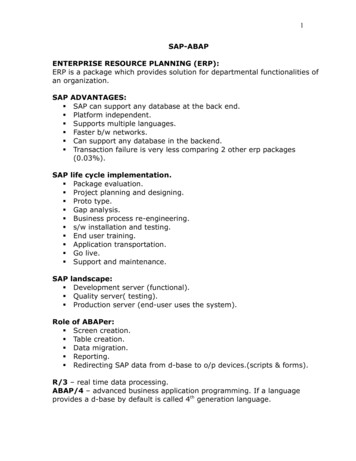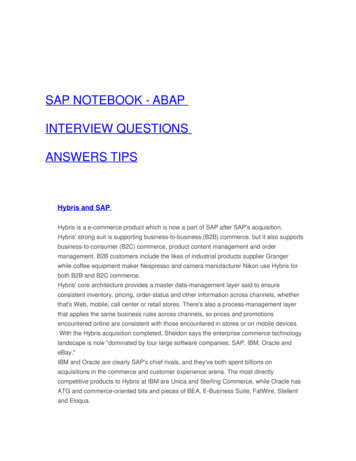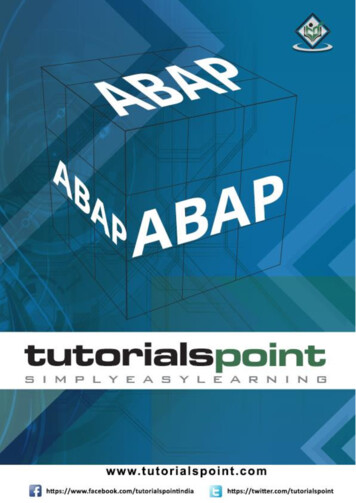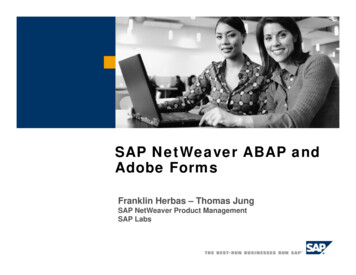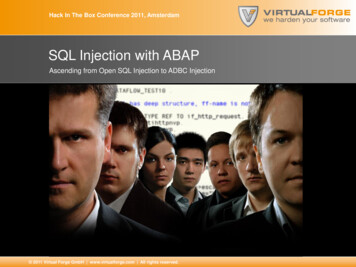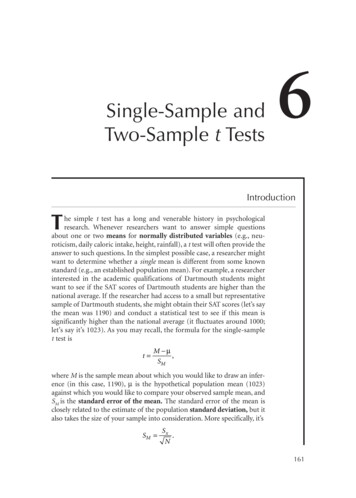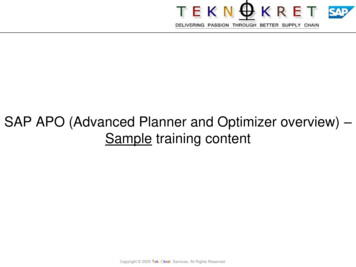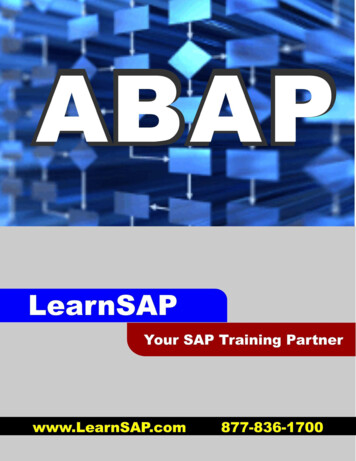
Transcription
SAP ABAPA Step-by-Step Guide5101 Camden Lane, Pearland, TX 77584
www.LearnSAP.comABAPIntentionally Left BlankVer: ECC 6.0Page: 2
www.LearnSAP.comABAPTable of Contents1.Introduction62.SAP Navigation7a.b.c.d.e.Login OnStandard Toolbar IconsStandard Exit KeysNew Session IconLogin Off3.History of ABAP114.SAP R/3 Architecture and ABAP125.ABAP Repository146.ABAP Workbench16a. Transaction Codes7.ABAP Workbench Tool Attributes21a. Development Objects and Packagesb. Storing Development Objectsc. Transport Organizer8.ABAP Keys23a. ABAP Developer keyb. ABAP Access Key9.Data Storage in SAP2610.ABAP Dictionary2711.Database Tables31a. Table Attributesb. Creating a New Database Table12.Database Table Views43a. Database Viewb. Projection View13.Parameter ID63a. Displayb. Creating New Parameter ID14.Ver: ECC 6.0Transport Package74Page: 3
www.LearnSAP.com15.Message ClassABAP80a. Creating a New Message Classb. Adding New Messages in Message Classc. Calling Messages in Program16.ABAP Function Module94a. Overviewb. Create Function Groupc. Create Function Module17.ABAP Editor and Program Attributes18.ABAP Reporting19.Dialog Programming104164a. Screen & Menu Designb. Tabstrip Control20.ABAP Workbench Version Management19321.ABAP Performance Tuning Tools198a. ABAP Debuggerb. Runtime Analysisc. Performance Trace22.Data Transfer Methodsa.b.c.d.23.210Transaction RecorderCall TransactionBatch Input SessionLSMWABAP List Viewer (ALV)231a. Featuresb. Standard Functions for ALV24.Saving and Printing of Reports23625.List of Transaction Code25126.Conclusion and Credits286Ver: ECC 6.0Page: 4
www.LearnSAP.comABAP1. IntroductionSAP stands for Systems, Applications and Products in Data Processing. Five GermanEngineers founded it in 1972. SAP is an ERP software which large organizations use tomanage their business. SAP has several modules, each of which represents a businessprocess. Modules are usually abbreviated for the business process they represent. Forinstance, HCM is Human Capital Management, FI for Financial Accounting, MM forMaterials Management and SD is Sales & Distribution and so on. All together there aresome nineteen core modules.These modules are highly integrated in real-time, which means, that if information is sharedbetween modules then the data is entered only once. This reduces the chances of errorarising from repetitive entry and also reduces the man-hours. Managers and decisionmakers always have information at their fingertips and this helps them in effective decisionmaking.SAP has been around for nearly four decades. Nine out of ten Fortune-500 companies havealready implemented SAP (not counting the thousands of to-be Fortune-500 companies thathave SAP). There are well over 10 million SAP users worldwide and jobs keep popping upall around the world.SAP is the leading ERP (Enterprise Resource Planning) software. Because of it’s liberalopen-architecture, there are millions of programmers working around the world to provideinteraction between thousands of major software and SAP.SAP is usually implemented in phases. The first phase is when organizational structure andaccounting components are configured, tested and then taken live. Gradually more modulesare turned on.ABAP CourseThe purpose of this book is to learn step-by-step basics of SAP’s programming languageABAP (Advance Business Application Programming). SAP’s complete software is written inABAP. The course is built to provide basic understanding and knowledge of ABAP’scapabilities and the utilization of the programming language to meet needs of a business.LearnSAPLearnSAP strives to help students develop SAP skills and knowledge needed to complete inthe employment market and adapt to future changes. The training course combinesclassroom theory of SAP technology with hands-on practice.LearnSAP strives to evolve with the marketplace, delivering skills-based education that issensitive to market needs and convenient to students. Our goal is to help people developinto employees who are equipped to meet the challenges of a marketplace where change isthe one constant.Ver: ECC 6.0Page: 5
www.LearnSAP.comABAP2. SAP Overview and Navigationa. Login On:Password The initial password is provided bysystem administrator Password is case sensitive System prompts for new passwordin a dialog box Click on “Enter” after reconfirmingthe new password.On changing the password, the copyrightinformation appears when you login for thefirst time, click on enter key here and youwill be logged in the SAP System.When logging on to an SAP system, you will be prompted to enter the user and password.You also have the option of specifying a client when logging on; the client field usuallyalready contains an appropriate default value, you can also select a logon languagesupported by that system. SAP systems can support a large number of languages, theminimum being English and German language.Ver: ECC 6.0Page: 6
www.LearnSAP.comABAPA SAP screen has following standard layout:Menu barStandard toolbarTitle barApplication ToolbarCommand FieldStatus barMenu bar:The Menu bar is the top line of any dialog window in the SAP system.Standard toolbar:Standard functions that are available in displayed in this toolbar. The applications likesave, top of page, end of page, page up, page down, print, etc.Title bar:Displays the name of the application/business process you are currently in.Application toolbar:Application specific menu options are available on this toolbar.Command Field:To start a business application without having to navigate through the menu transactioncodes are assigned to the business processes. Transaction codes are entered in thecommand field to directly start the application.Ver: ECC 6.0Page: 7
www.LearnSAP.comABAPb. Standard Toolbar Icons:EnterConfirms entered dataDoes not save workScroll buttonsLayout menuFirst page, previous page,next page and last pageCustomizes the Display options Printout the screenBackReturns to previous screenwithout saving dataF1 HelpProvides help on the field wherethe cursor is positionedCommand fieldPrintUsed to enter command,transaction code. Todisplay it, click the arrowPrint current screenCancelExit current taskwithout saving dataSaveSaves the work(Hard Copy)ExitReturns to initial screenwithout saving dataCreate shortcutCreate a shortcut to anyreport, transactionCreate sessionCreate a new sessionFind and Find nextSearch for data in current screen;extend researchc. Standard Exit Keys:Exit KeysBackCancelExit TransactionOr Log Offd. New Session Icon:Ver: ECC 6.0Page: 8
www.LearnSAP.comABAPe. Login Off:It is a good practice to log off from the SAP system when you finish your work. There areseveral ways of login off from the system: From Menu, select system - log off Close the open sessions and the last session will log you off Enter /nex in the command fieldBefore the system logs you out, a dialog box is displayed to confirm you want to log off fromthe system, except for the option /nex in the command field.Ver: ECC 6.0Page: 9
www.LearnSAP.comABAP3. History of ABAPABAP is a proprietary programming language of SAP and ABAP stands for “AdvancedBusiness Application Programming”.Originally, known as Allgemeiner Berichts-Aufbereitungs-Prozessor, German for generalreport creation processorABAP is a 4th Generation Programming Language and was first developed in 1980s. By1990s most of SAP’s application software and systems were written in ABAP. In 1999 ABAPwas extended to include Object Oriented Programming. SAP’s most recent development ison ABAP as well as JAVA platform.Attributes and Prerequisites: The language is fairly easy to learn for programmers but it is not easy for use by nonprogrammers. Knowledge of relational database design and preferably also of object-orientedconcepts is necessary to create ABAP programs. The ABAP programming language allows SAP customers to enhance SAPapplication programs – customers can develop custom reports and interfaces withABAP programming. SAP ABAP programs all are stored in the SAP database and not in form of separateexternal files like other program files eg Java, c , etc.RDBMSA relational database management system (RDBMS) is a database managementsystem (DBMS) that is based on the relational model as introduced by E. F. Codd. Mostpopular databases currently in use are based on the relational database model.A short definition of an RDBMS is: a DBMS in which data is stored in tables and therelationships among the data are also stored in tables. The data can be accessed orreassembled in many different ways without having to change the table forms.A relational database is a database that conforms to relational model theory. Thesoftware used in a relational database is called a relational database managementsystem (RDBMS). Colloquial use of the term "relational database" may refer to theRDBMS software, or the relational database itself. A relational database is thepredominant choice in storing data, over other models like the hierarchical databasemodel or the network model.A relation is usually described as a table, which is organized into rows and columns. Allthe data referenced by an attribute are in the same domain and conform to the sameconstraints.Ver: ECC 6.0Page: 10
www.LearnSAP.comABAP4. SAP R/3 Architecture and ABAPSAP R/3 is based on Client Server Architecture and the model is based on three-tierhierarchy.The presentation layer- User Interface (users interact with the system with help of SAPGUI or through web-GUI)The Application layer- All the programs related to business applications written in ABAPare executed here.The Database layer- Data is stored in this layer in a RDBMS.Ver: ECC 6.0Page: 11
www.LearnSAP.comABAPInteraction between the different layers and ABAP:The interaction between the user and the ABAP programs which are executed in theApplication layer is the main goal of this step by step. ABAP programs are processed orexecuted in the application server. The design of user interaction with the database iscarried out via the ABAP programs.User accesses the application programs through the SAP GUI which is installed on thepresentation server. User action like clicking on Enter or Function key, the control is passed from thepresentation server to the application server. In the application Server, the ABAP program is processed based on the user actionand if needed further dialog is triggered with the user by passing the control to thePresentation server, else if the application needs access to the “data” to eitherretrieve data or store date, the control of the program is passed to the DatabaseServer. On retrieving the data or saving the data, the Database passes the control to theApplication server and then the ABAP program passes the information to the userwhen control is transferred back to the Presentation Server.Ver: ECC 6.0Page: 12
www.LearnSAP.comABAP5. ABAP RepositoryThe Repository contains all of the development objects of the system. The Repository isused to store both objects – defined by SAP as well as objects defined by customers.Attributes of Repository objects: The Repository is in the SAP system’s central database The Repository objects are client independent – means that Repository objects canbe accessed from any client. The Repository is sub-divided depending on application components called subobjects. A Repository Object is always assigned to a development class called package fromECC.To reach the Repository the menu path is as follows:Menu Path:SAP Easy Access Tools ABAP Workbench Overview InformationSystemTCode SE84Ver: ECC 6.0Page: 13
www.LearnSAP.comABAPThe repository structure can be viewed by selecting a component from the tree structure.Double click on a object type you want information on, a selection screen will be displayed tohelp facilitate the search.Ver: ECC 6.0Page: 14
www.LearnSAP.comABAP6. ABAP WorkbenchThe ABAP Workbench includes all the tools required for maintaining Repository Objects fordevelopment of application programs.The various tools are: ABAP Editor Data Dictionary Menu Painter Screen Painter Function Builder Debugger Object NavigatorEach of the tools can be called explicitly and then a Repository object loaded for processing.Object Navigator is a single point tool to access all the workbench objects.To reach the ABAP Workbench for development, the menu path is as follows:Menu Path:SAP Easy Access Tools ABAP Workbench DevelopmentAll the development objects, ABAP Editor, Data Dictionary, Function Builder, etc required forthe maintenance of the Repository are under this menu option.Ver: ECC 6.0Page: 15
www.LearnSAP.comABAPOne can go to any application in the system by navigating through the menu path or byentering the transaction codes for the application in the “command” field.Ver: ECC 6.0Page: 16
www.LearnSAP.comABAPTransaction Codes:Each function / application in the SAP system is assigned a transaction code. Atransaction code consists of letters, numbers or both. You enter transaction code in thecommand field which will take you to the SAP application faster as against navigating viamenu path. A transaction code can be up to 20 characters longA transaction code should begin with a letterEnter the transaction code in the “Command Field” and choose ENTER Command Field:The command field is on the standard tool bar and you can either hide the commandfield or display it by choosing the arrow to the left of the “SAVE” icon.Command FieldTo display the transaction codes for the applications, there are 2 ways:1. If you are in an application, and want to know the transaction code for the same, thenfrom the menu bar, choose System - Status and in the system status dialog box,the transaction code for the current application will be displayed.Ver: ECC 6.0Page: 17
www.LearnSAP.comABAPIn the status, you will get the transaction codeVer: ECC 6.0Page: 18
www.LearnSAP.comABAP2.
The purpose of this book is to learn step-by-step basics of SAP’s programming language ABAP (Advance Business Application Programming). SAP’s complete software is written in ABAP. The course is built to provide basic understanding and knowledge of ABAP’s capabilities and the utilization of the programming language to meet needs of a business. LearnSAP LearnSAP strives to help students .
